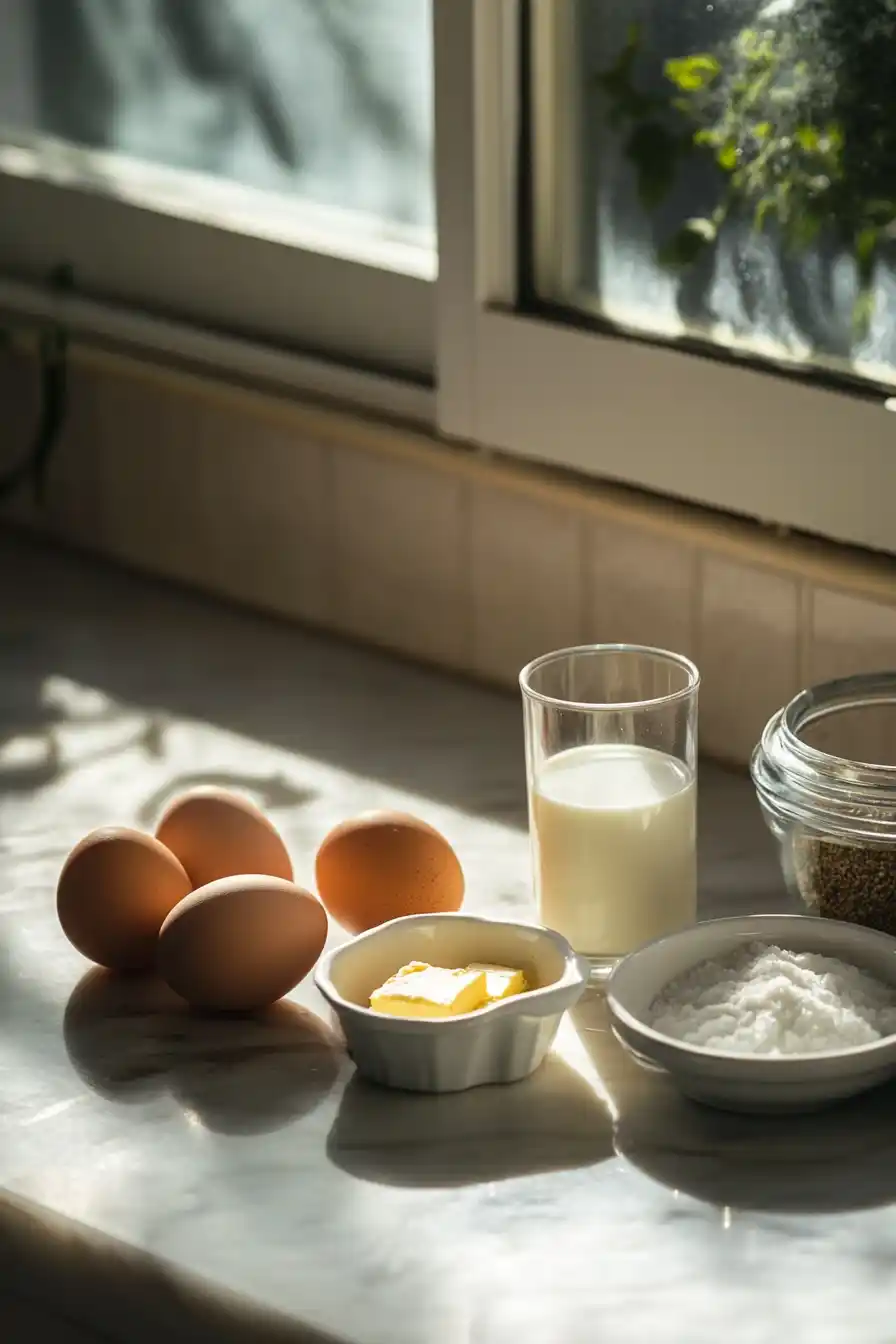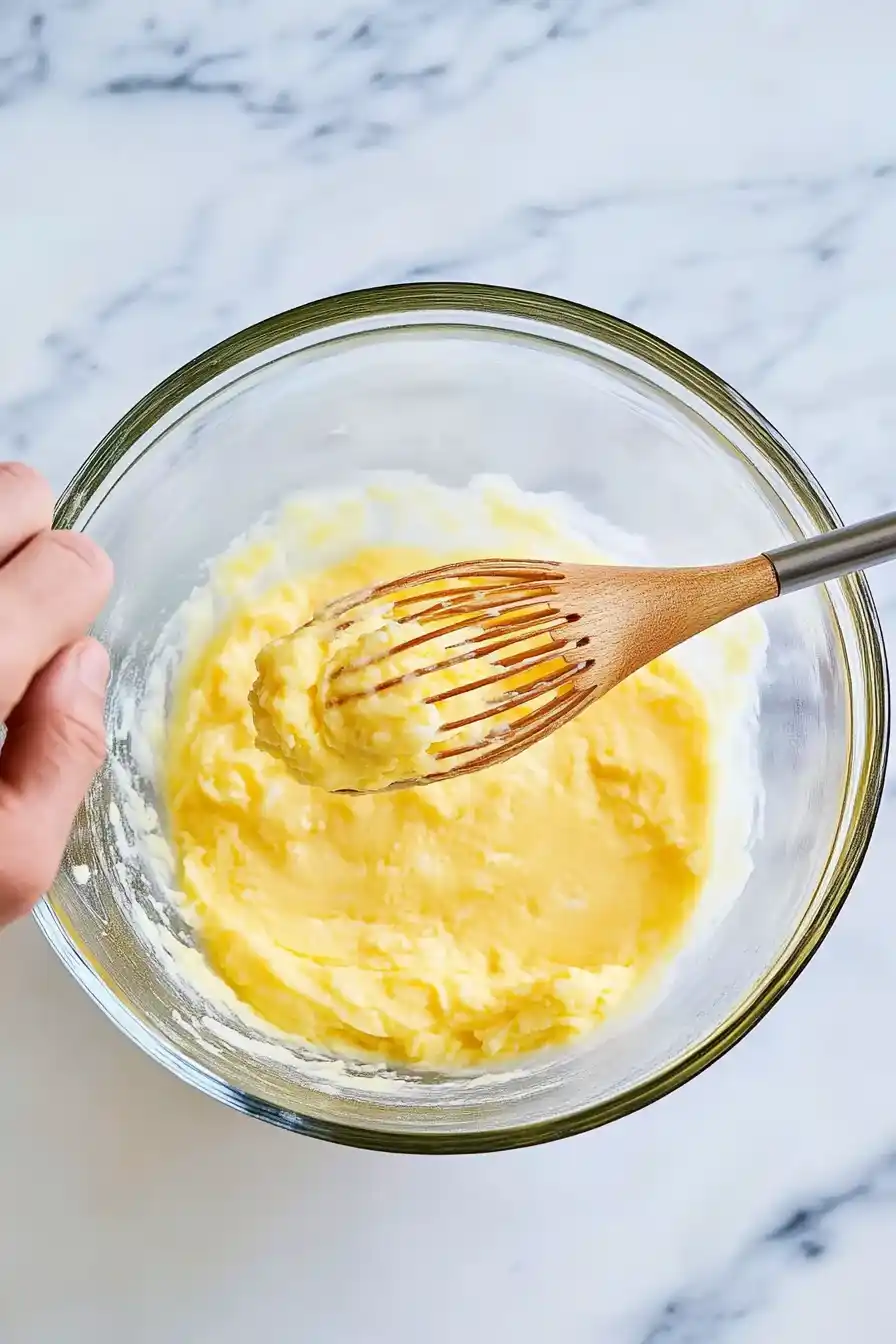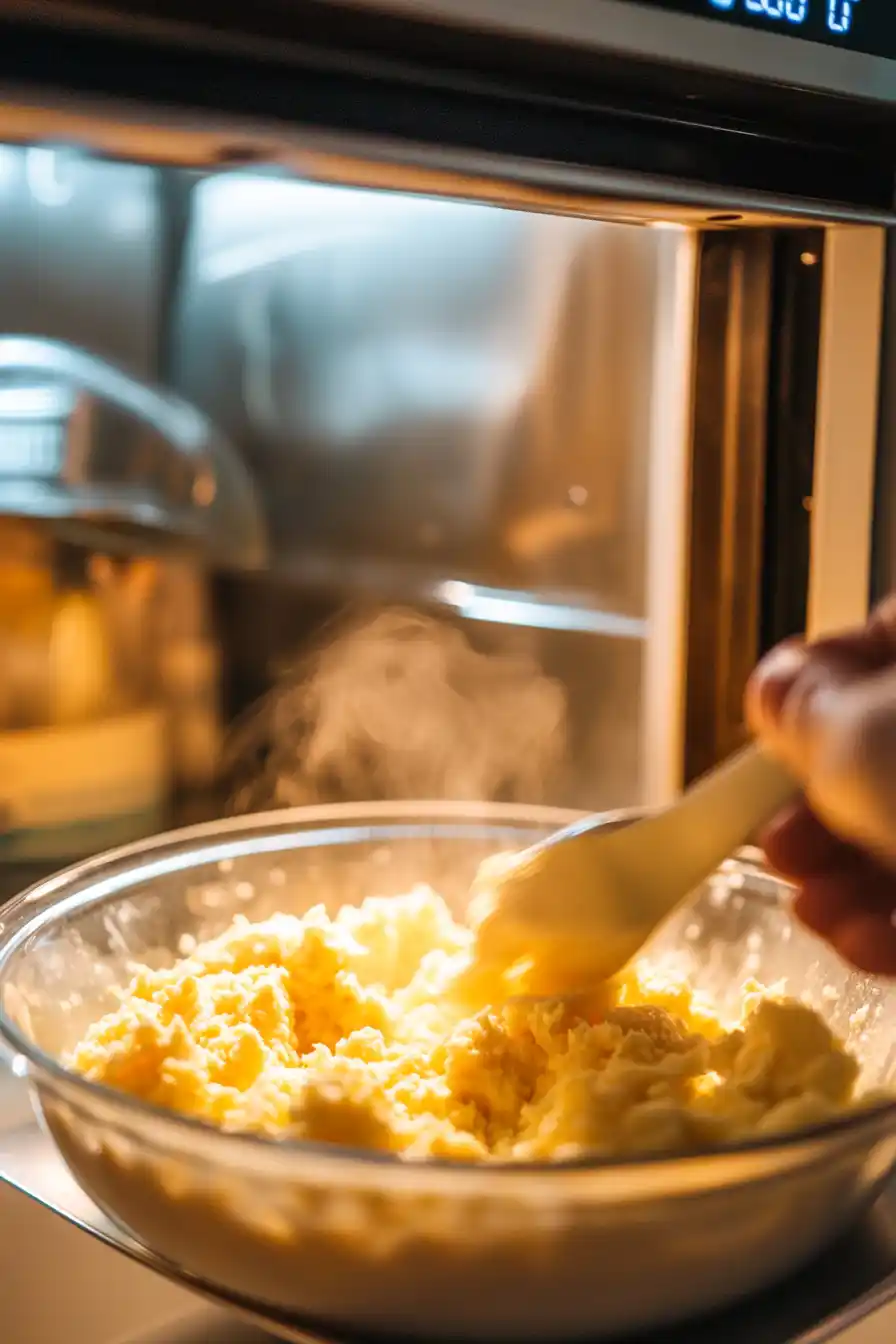Last updated on: February 6, 2025
Scrambled eggs are a breakfast favorite, but using a stove can take time and create a mess. What if you could cook them faster, with less cleanup, and still get a fluffy texture? That’s where microwave scrambled eggs come in.
With just a few simple steps, you can make soft, creamy eggs in two minutes or less. Whether you’re in a hurry before work, need a quick protein boost, or want a no-fuss recipe, this guide will show you how to make perfect microwave scrambled eggs every time.

Table of Contents
Why Choose Microwave Scrambled Eggs?
Cooking scrambled eggs in a microwave is one of the easiest and fastest methods. But why should you choose this over traditional stovetop cooking?
The Benefits of Microwave Scrambled Eggs
- Time-Saving: Ready in two minutes instead of the usual 10-15 minutes on a stove.
- Fewer Dishes: No need for pans, spatulas, or extra utensils.
- Perfect for Beginners: No risk of burning or overcomplicated steps.
- Healthier Cooking: Uses less oil or butter compared to stovetop methods.
- Kid-Friendly: Safe and easy enough for children to make with supervision.
“If you’ve ever struggled with messy stovetop scrambled eggs, switching to a microwave method is a game-changer!”
How Microwave Scrambled Eggs Compare to Stovetop Scrambled Eggs
| Feature | Microwave Scrambled Eggs | Stovetop Scrambled Eggs |
|---|---|---|
| Cooking Time | 1-2 minutes | 5-10 minutes |
| Texture Control | Fluffy and soft with proper stirring | More control over texture |
| Cleanup | Only one microwave-safe bowl | Requires a pan and utensils |
| Difficulty Level | Very easy, great for beginners | Requires practice |
Both methods have their place, but if you value speed and simplicity, the microwave method is the clear winner.
Who Should Try This Method?
- Busy professionals who need a quick breakfast.
- Students with limited time and kitchen access.
- Parents looking for an easy meal option for kids.
- Anyone who wants an effortless way to enjoy delicious scrambled eggs.
Ingredients & Equipment Needed
Before you start cooking, let’s gather everything you need. The best part? You only need a few simple ingredients!

Essential Ingredients for Microwave Scrambled Eggs
Here’s what you need to make the best microwave scrambled eggs:
Ingredient Checklist
| Check | Ingredient | Quantity |
|---|---|---|
| Eggs | 2 large | |
| Milk or water | 2 tbsp | |
| Salt | To taste | |
| Black pepper | To taste | |
| Butter or oil | ½ tsp | |
| Shredded cheese (optional) | ¼ cup |
Nutrition Facts
| Nutrient | Amount | % Daily Value |
|---|---|---|
| Calories | 150 | 8% |
| Protein | 12g | 24% |
| Fat | 10g | 15% |
| Carbohydrates | 1g | 0% |
| Calcium | 50mg | 5% |
Choosing the Best Eggs and Seasonings
The quality of eggs affects the texture and taste of your scrambled eggs. Here’s what to look for:
- Fresh eggs – Firmer whites and brighter yolks create better texture.
- Organic or free-range eggs – Often have a richer taste.
- Egg substitutes – If you prefer a lower cholesterol option, liquid egg whites work well.
For seasoning, you can keep it simple with salt and pepper, or try:
- Paprika – Adds a smoky touch.
- Garlic powder – Enhances the savory flavor.
- Italian seasoning – Pairs well with eggs and cheese.
Choosing the Best Equipment
To make microwave scrambled eggs, you’ll need:
- A microwave-safe bowl – Avoid plastic containers that may warp.
- A fork or whisk – Helps mix the eggs evenly.
- A microwave cover or plate – Prevents splatters.
Tip: A ceramic mug can work well if you don’t have a microwave-safe bowl.
Step-by-Step Guide: How to Make Microwave Scrambled Eggs
Cooking microwave scrambled eggs is simple, but following the right steps ensures they turn out soft, fluffy, and delicious every time. Many people struggle with eggs that come out rubbery or overcooked, but with the right technique, you’ll get perfect results in just two minutes.
Step 1: Prepare the Eggs

Start by cracking two large eggs into a microwave-safe bowl. Using a ceramic or glass bowl is best, as plastic can warp under high heat.
How to Whisk Eggs for the Best Texture
- Use a fork or whisk to beat the eggs until the yolks and whites are fully combined.
- Add 2 tablespoons of milk or water to the eggs. This helps create a creamier, softer texture.
- Season with a pinch of salt and black pepper for flavor.
Tip: Want extra fluffiness? Add a small pinch of baking powder before whisking.
Step 2: Choose the Right Cooking Settings
Not all microwaves cook the same, so adjusting the time and power level is key.
- Microwave Power Level: Use medium (50-70%) power to avoid overcooking.
- Total Cooking Time: 1 minute 30 seconds to 2 minutes, depending on the microwave wattage.
| Microwave Wattage | Cooking Time |
|---|---|
| 700W | 2 minutes |
| 1000W | 1 minute 30 seconds |
| 1200W | 1 minute 15 seconds |
Tip: Start with a shorter time, then check and stir the eggs to prevent overcooking.
Step 3: Microwave in Intervals
Instead of microwaving the eggs all at once, cook them in short bursts to ensure even cooking.
- Microwave for 30 seconds, then remove and stir with a fork.
- Repeat in 15-second intervals, stirring each time.
- Stop cooking when the eggs look slightly underdone—they will continue cooking with residual heat.
Why stir in between? Stirring prevents overcooked edges and ensures a fluffy texture.
Step 4: Add Mix-Ins for Extra Flavor
After the eggs are cooked, you can customize them to your liking:
- Cheesy eggs: Stir in ¼ cup shredded cheese while the eggs are still warm.
- Vegetable-packed eggs: Add diced bell peppers, spinach, or onions.
- High-protein boost: Mix in grilled chicken or cottage cheese.
Tip: To make an easy creamy parmesan Italian sausage soup, crumble some cooked turkey sausage and mix it into your eggs for a hearty, protein-rich meal.
Common Mistakes & How to Avoid Them

Even though making microwave scrambled eggs is easy, there are a few mistakes that can ruin their texture. Here’s how to avoid them.
Overcooking: Preventing Rubbery Eggs
Many people complain that microwave eggs become rubbery. This happens when they are cooked too long or at too high a power setting.
- Solution: Cook in short intervals (15-30 seconds) and stir frequently.
- Tip: Remove eggs when they look slightly undercooked, as they will firm up from the heat.
Not Stirring Enough: Avoiding Uneven Cooking
If you don’t stir between intervals, you might end up with runny parts and overcooked edges.
- Solution: Stir every 15-30 seconds to distribute heat evenly.
- Tip: Use a fork for gentle mixing without breaking up the texture too much.
Using the Wrong Bowl: Preventing Spills & Safety Hazards
Eggs can spill over the edges if the bowl is too small, leading to a messy microwave.
- Solution: Use a deep, microwave-safe bowl.
- Tip: Cover loosely with a microwave-safe lid or plate to prevent splatters.
Tips to Make Microwave Scrambled Eggs Even Better
Want to take your microwave scrambled eggs to the next level? Try these expert tips.
Best Seasonings for Extra Flavor
While salt and pepper are classic choices, you can experiment with different seasonings to add a unique touch.
| Seasoning | Flavor Profile |
|---|---|
| Paprika | Smoky, slightly sweet |
| Garlic Powder | Rich, savory taste |
| Italian Seasoning | Herby and aromatic |
| Red Pepper Flakes | Spicy kick |
Adding Cheese, Vegetables & Protein
Customizing your eggs makes them more nutritious and satisfying.
- Cheese lovers: Add shredded cheddar, mozzarella, or feta.
- Healthy option: Mix in spinach, tomatoes, or mushrooms.
- Protein boost: Stir in cooked turkey sausage or grilled chicken.
Tip: Pair these eggs with creamy parmesan Italian sausage soup for a delicious, protein-packed meal.
How to Get a Creamier Texture
If you love soft, creamy eggs, try these tricks:
- Use milk instead of water when whisking.
- Cook eggs at 50-70% power instead of full power.
- Stir gently to avoid breaking the egg curds too much.
Preventing Sticking & Mess in the Microwave
Cooking eggs in the microwave can sometimes cause sticking or spills. Here’s how to prevent that.
Choosing the Right Microwave-Safe Dish
Using the wrong dish can lead to overflow or uneven cooking.
- Solution: Pick a deep ceramic or glass bowl.
- Tip: Avoid plastic containers, as they may not handle heat well.
Using Butter or Cooking Spray
Eggs tend to stick to the bowl, making cleanup harder.
- Solution: Grease the bowl with butter or a light coat of oil.
- Tip: If you’re avoiding extra fat, use a non-stick cooking spray instead.
Stirring to Prevent Clumping
Without stirring, eggs clump together unevenly.
- Solution: Stir gently every 15-30 seconds to prevent lumps.
- Tip: Use a rubber spatula instead of a fork for a softer texture.
Serving Suggestions & Meal Pairings
Now that you’ve mastered how to cook microwave scrambled eggs, let’s explore the best ways to serve them. Whether you’re looking for a quick breakfast, a high-protein meal, or a nutritious snack, pairing your eggs with the right sides can enhance both flavor and nutrition.
Best Breads and Toasts to Pair with Microwave Scrambled Eggs
A warm, crispy slice of toast is a classic companion for scrambled eggs. It adds texture and makes the meal more satisfying.
| Bread Type | Why It Works Well |
|---|---|
| Whole Wheat Toast | High in fiber, supports digestion |
| Sourdough Bread | Light, tangy flavor complements eggs |
| Multigrain Bread | Packed with seeds and grains for extra nutrition |
| English Muffin | Soft inside, crispy outside—great with butter |
| Low-Carb Wrap | A keto-friendly option for making an egg wrap |
For a quick breakfast wrap, place your microwave scrambled eggs in a whole wheat or low-carb wrap, add some cheese and veggies, and roll it up for a delicious, portable meal.
Protein-Rich Sides for a High-Energy Breakfast
Pairing microwave scrambled eggs with protein-packed sides can keep you full for longer and provide lasting energy.
- Grilled chicken strips – Lean protein for muscle support.
- Turkey sausage – A flavorful, lower-fat alternative to traditional sausage.
- Cottage cheese – High in protein and adds a creamy texture.
- Greek yogurt with honey – A mix of protein and natural sweetness.
- Nut butter on toast – Adds healthy fats and protein for a balanced meal.
For an extra boost, try serving your microwave scrambled eggs alongside creamy parmesan Italian sausage soup. The combination of eggs, cheese, and rich broth makes for a satisfying, protein-packed meal.
Healthy Breakfast Ideas: Avocado, Fruits & More
If you’re looking for lighter, nutritious pairings, try these fresh and healthy sides.
- Avocado slices – Loaded with healthy fats and creamy texture.
- Tomato and cucumber salad – A refreshing, crunchy contrast to warm eggs.
- Berries and nuts – Provides antioxidants and protein.
- Steamed spinach or kale – Adds extra vitamins and minerals.
- Oatmeal with cinnamon – A fiber-rich side for a well-rounded breakfast.
Tip: Add a spoonful of cottage cheese to your scrambled eggs for a creamy, protein-rich twist.
Frequently Asked Questions (FAQs)
Many people have questions and concerns about cooking microwave scrambled eggs. Below, we answer some of the most common ones.
Is It Okay to Microwave Scrambled Eggs?
Yes! Microwaving scrambled eggs is perfectly safe, as long as you use a microwave-safe bowl and cook in short intervals. In fact, this method preserves more nutrients than frying because it requires less oil or butter.
How Long Should You Put Eggs in the Microwave?
The cooking time depends on your microwave’s power level. Here’s a general guide:
| Microwave Wattage | Cooking Time |
|---|---|
| 700W | 2 minutes |
| 1000W | 1 minute 30 seconds |
| 1200W | 1 minute 15 seconds |
To prevent overcooking, microwave in 15-30 second intervals, stirring between each.
How Do You Microwave Scrambled Eggs Without Them Sticking?
Eggs can stick to the bowl if the surface is dry or the cooking temperature is too high. To prevent sticking:
- Grease the bowl with butter or a light coat of oil.
- Use a non-stick, microwave-safe ceramic or glass bowl.
- Stir frequently to distribute heat evenly.
How Do You Cook Eggs in the Microwave Without Making a Mess?
Microwave eggs can sometimes overflow or splatter, leaving a mess. Here’s how to prevent it:
- Use a deep bowl to allow room for the eggs to expand.
- Cover with a microwave-safe lid or plate to contain splatters.
- Reduce the power level to 50-70% instead of using full power.
- Stir in between cooking intervals to prevent uneven rising.
Final Thoughts & Next Steps
Microwave scrambled eggs are one of the fastest, easiest, and most convenient ways to enjoy a healthy meal. In just two minutes, you can have fluffy, delicious eggs without the hassle of stovetop cooking.
Whether you eat them plain, with cheese, in a wrap, or paired with healthy sides, this method is perfect for busy mornings, students, and anyone who loves a quick meal.
Now it’s your turn! Try making microwave scrambled eggs today and customize them with your favorite mix-ins.
For more easy and nutritious meal ideas, check out our other quick recipes, including creamy parmesan Italian sausage soup, a hearty and delicious dish that pairs perfectly with your eggs!

